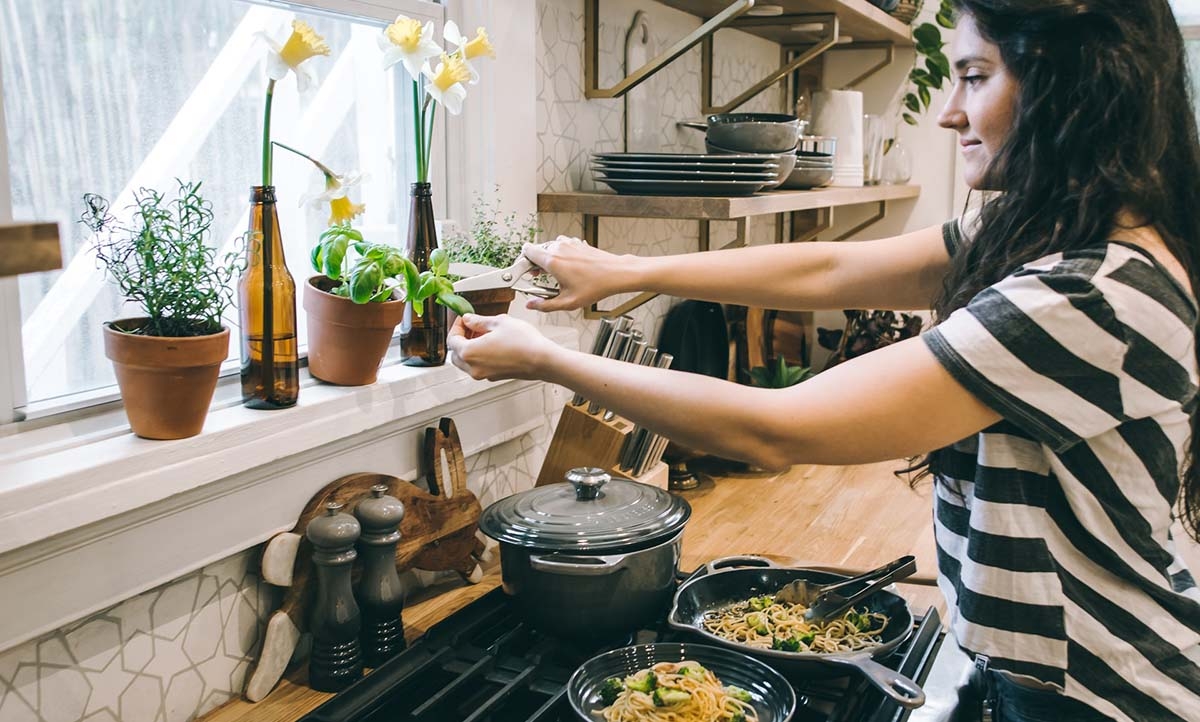
Cooking with basil 101: Everything there is to know about the tasty herb
Basil is one of the most popular herbs in use today. It’s a beautiful and brightly-coloured herb that originated in Africa and Southeast Asia but is now used worldwide. It is widespread in Thai, Indonesian and Vietnamese cuisines as well as in traditional Italian dishes. You’re probably most familiar with it being used either as a garnish or in pesto.
Basil is sometimes referred to as “the king of herbs” and has a minty flavour. Not only is it tasty, but it’s also straightforward to grow at home and is quite commonly found in kitchen gardens.
Today, you’ll learn about:
- What basil is used for
- Different types of basil
- How to store basil
- How to grow your own basil
So let’s get started!
What is basil used for?
Basil is an incredibly versatile herb that has a variety of uses in cooking. It can be:
- Preserved in vinegar or olive oil
- Used in Italian dishes such as pesto
- Sprinkled over salads
- Used to add flavour to vegetables, poultry and fish
Basil can be used both fresh and dried. Even basil flowers are edible and can be added to salads and other dishes. In addition to being great in food, basil is often used as a fragrant addition to potpourri and sachets. Basil oil is also a common ingredient in shampoos, perfumes and soaps.
Different Types of Basil for Cooking
If you’re interested in using basil in your cooking, you’ve got lots of options. The type of basil you use will depend on your personal taste and the kind of dish you are preparing.
It’s important to consider what’s most important to you when choosing your basil. Is it flavour? Colour? How does the basil look? Thinking about all this before you start shopping for basil will help make it easier for you to decide which type of basil is right for you.
Italian Large Leaf Basil
As you can guess from the name, this basil is commonly used in Italian dishes. It has large, tasty leaves and is the main ingredient in making pesto, giving it a distinctive strong, green colour. Italian large leaf basil also makes an excellent garnish for most Italian dishes, particularly with tomatoes — it’s great with bruschetta!
Sweet Basil
Sweet basil is another excellent and popular option if you are making pesto. It has a mild, sweet flavour but can be quite strong if you use too much of it. So if you are using it as a garnish, apply it sparingly.
If you are planning to cook with sweet basil, you can help bring out its flavour by soaking it overnight in olive oil.
Thai Basil
Thai basil has a bolder and spicier flavour than sweet basil. It can be used in most dishes and works well eaten either raw, sprinkled over the top of a salad or cooked in sauces or soups. Its taste blends easily with most foods, so it complements, rather than overpowers, the other ingredients.
It can have a slightly bitter flavour, so you may want to use it in small amounts at first. Do some taste testing after you’ve added a bit and mixed it in — just to make sure you get the effect you want.
Red Rubin Basil
Red Rubin basil has quite a sharp taste — similar to cloves. It’s considered more pungent than other types of basil.
Red Rubin basil can be an excellent choice for cooking or for making flavoured vinegar. It’s also a good choice if you’re looking to add some colour to your food, as Red Rubin basil leaves are actually purple. If you like the taste but not the colour, simply cook the basil, and the leaves will turn from purple to green.
Lemon Basil
Lemon basil gets its name from its distinct lemony taste. It can be a great choice for adding flavour to dishes like grilled fish or shrimp. Plus, it can add a little zing to your pesto if you want to use it in a more traditional basil dish.
When you use lemon basil, be careful not to overcook it as too much heat can dissipate the flavour. In general, you should make sure that your lemon basil is fresh and plan to add it when your dish is almost finished.
Cinnamon Basil
Cinnamon basil is related to sweet basil, but it includes something called methyl cinnamate that you don’t find in sweet basil. Methyl cinnamate is what provides the cinnamon spice with both its flavour and aroma.
Like lemon basil, it’s best to use cinnamon basil while it’s fresh and avoid overcooking. Its unique taste gives a delicious flavour to a wide range of foods: you can use it in sauces, soups or stews, and it also goes well with honey, baked goods, and even tea!
How should I store basil?
A key thing to keep in mind with basil is that it’s best to use it as soon as possible after you pluck it from your garden or bring it home from the store — that’s when it tastes best, and besides, basil tends to wilt or go bad quite fast.
To help basil keep longer, you can wrap it in a damp paper towel, put it in a plastic bag and then store it in your fridge. Or you can store it in a jar or glass of cold water. If you have fresh basil you don’t plan to use for a while, then it’s best to freeze it.
How do I grow my own basil?
Growing your own basil is a fun, inexpensive way to make sure you always have access to basil, whatever the season. After you plant your basil seeds, make sure they are warm and get plenty of sunlight. Once you harvest your basil, you can freeze any leftovers to ensure that you don’t waste the basil and can have it at your fingertips over the winter.
While it’s certainly enjoyable to grow your own basil and come up with your own recipes, it’s not for everyone. Meal kit companies like HelloFresh, Chefs Plate and GoodFood deliver everything you need to whip up the perfect basil-infused meal directly to your front door. HelloFresh in particular offers a lot of great options that show you how to use basil, including a tasty chicken and basil stir fry.
You’re Ready to Start Cooking With Basil!
You’ve now learned so much about basil. You can stick to using basil in traditional dishes like pesto — but you certainly don’t have to. Depending on the type of basil you pick, it can be an excellent addition to soups, stews, sauces, and you can even add it to your baking! Try different basils in the same dish and see how it turns out.
Another great way to add the taste of basil to your food is to infuse it in olive oil. Basil-infused olive oil can be a tasty addition to pasta or pizza. Try dipping fresh bread in it — tastes amazing! It’s fairly easy to make basil-infused olive oil. It’s simply a matter of blending your ingredients and then heating them. When you’re done, you have fantastic-tasting olive oil to use in your everyday cooking. It can even be a tasty and practical gift to give to friends and loved ones.
Finally, you may be ready after reading all of this to grow your own basil. You may not be able to find seeds for every type of basil, but you should certainly be able to find seeds for the more common types, such as sweet basil. You can either plant it outdoors in good weather or grow it inside over the winter. Either way, make sure that your basil plant stays warm and is in a place where it will get lots of sunshine.
Basil is a fantastic, colourful and versatile herb. Whether you want just to use a little bit as a garnish or try adding it to olive oil, you’re sure to get great-tasting food when you use basil.








